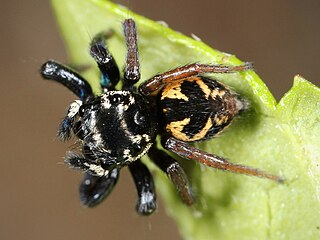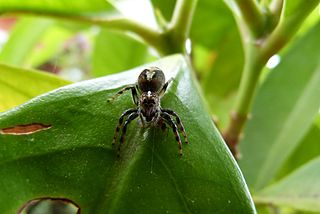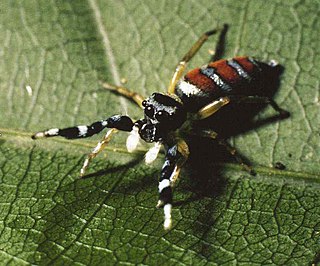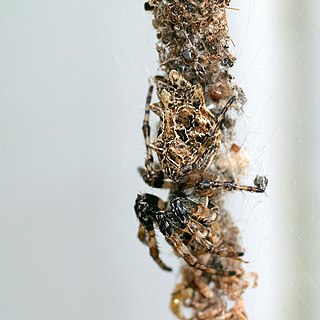Asaracus is a genus of South American jumping spiders that was first described by Carl Ludwig Koch in 1846.

Breda is a genus of jumping spiders that was first described by George Peckham & Elizabeth Peckham in 1894.

Corythalia is a genus of jumping spiders that was first described by Carl Ludwig Koch in 1850. The genus is distributed throughout most of the Western Hemisphere. Species of this genus are found in The Americas.

Dendryphantes is a genus of jumping spiders that was first described by Carl Ludwig Koch in 1837.

Frigga is a genus of jumping spiders that was first described by Carl Ludwig Koch in 1850. The name is derived from Frigga, a Norse goddess.

Marpissa is a genus of jumping spiders that was first described by Carl Ludwig Koch in 1846. The name is derived from Marpissa, an ancient Greek village.

Pachomius is a genus of jumping spiders that was first described by George and Elizabeth Peckham in 1896. Uspachia was merged into genus Romitia in 2007, and all nine species were merged into Pachomius in 2015. The name is derived from Pachomius, the founder of cenobitic monasticism.

Phiale is a genus of jumping spiders that was first described by Carl Ludwig Koch in 1846. P. albovittata has been considered a junior synonym of Freya perelegans since 2006.

Psecas is a genus of jumping spiders that was first described by Carl Ludwig Koch in 1850.

Cyclosa, also called trashline orbweavers, is a genus of orb-weaver spiders first described by Anton Menge in 1866. Widely distributed worldwide, spiders of the genus Cyclosa build relatively small orb webs with a web decoration. The web decoration in Cyclosa spiders is often linear and includes prey remains and other debris, which probably serve to camouflage the spider. The name "Cyclosa" comes from Greek 'to move in a circle', referring to how it spins its web.

Micrathena, known as spiny orbweavers, is a genus of orb-weaver spiders first described by Carl Jakob Sundevall in 1833. Micrathena contains more than a hundred species, most of them Neotropical woodland-dwelling species. The name is derived from the Greek "micro", meaning "small", and the goddess Athena.

Theridion is a genus of tangle-web spiders with a worldwide distribution. Notable species are the Hawaiian happy face spider (T. grallator), named for the iconic symbol on its abdomen, and T. nigroannulatum, one of few spider species that lives in social groups, attacking prey en masse to overwhelm them as a team.

The Dendryphantina are a subtribe of jumping spiders that occur mainly in the New World. The subtribe was first defined by Anton Menge in 1879 as Dendryphantidae. Females of the subtribe generally show paired spots on the abdomen, and the males often have enlarged chelicerae. Females in this subtribe typically have S-shaped epigynal openings.

Amycini is a tribe of jumping spiders. It has been treated as the subfamily Amycinae.

Colonus is a genus of spiders in the jumping spider family, Salticidae. Colonus species are endemic to North and South America, ranging from New York to Argentina. All members of the genus have two pairs of bulbous spines on the ventral side of the first tibiae. The function of these spines is unknown. Colonus was declared a junior synonym of Thiodina by Eugène Simon in 1903, but this was reversed by Bustamante, Maddison, and Ruiz in 2015.

Trechalea is a genus of spiders in the family Trechaleidae. The species of this genus are found in the New World from the United States south to Peru and Brazil.

Corinna is a genus of corinnid sac spiders first described by Carl Ludwig Koch in 1841. They are found in Mexico and south to Brazil, and with selected species found in Africa.

Thymoites is a genus of comb-footed spiders that was first described by Eugen von Keyserling in 1884.

















